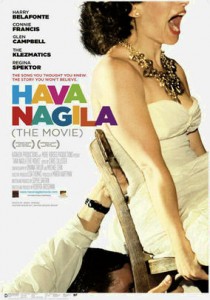 Interesting story today on NPR about a new movie documentary on the classic Jewish song Hava Nagila (Hebrew for Let us rejoice). Anyone having attended a Jewish wedding or bar mitzvah is likely to have heard the song and seen the ceremonial hoisting in the air of the honored individual(s) in a chair. According to the story, the song originated as a Hassidic nigun, or wordless prayer or melody from Ukraine and text was subsequently added by Jewish musicologist, Abraham Zvi Idelsohn in 1905. Idelsohn had lingusitic and political movitations, according to film maker, Robert Grossman: “There were people who were, of course, revitalizing Hebrew as a modern spoken language, and then there were people who were using that modern spoken language to create poetry…Edelson had in his mind that if you could create a repertoire of folk song drawing on the roots of Jewish music from all over the world, in this case from Eastern Europe, and added Hebrew lyrics to it, then you could create a folk repertoire for the new nation, and that would help build the nation.”
Interesting story today on NPR about a new movie documentary on the classic Jewish song Hava Nagila (Hebrew for Let us rejoice). Anyone having attended a Jewish wedding or bar mitzvah is likely to have heard the song and seen the ceremonial hoisting in the air of the honored individual(s) in a chair. According to the story, the song originated as a Hassidic nigun, or wordless prayer or melody from Ukraine and text was subsequently added by Jewish musicologist, Abraham Zvi Idelsohn in 1905. Idelsohn had lingusitic and political movitations, according to film maker, Robert Grossman: “There were people who were, of course, revitalizing Hebrew as a modern spoken language, and then there were people who were using that modern spoken language to create poetry…Edelson had in his mind that if you could create a repertoire of folk song drawing on the roots of Jewish music from all over the world, in this case from Eastern Europe, and added Hebrew lyrics to it, then you could create a folk repertoire for the new nation, and that would help build the nation.”
Strangely, Hava Nagila became widely known in the United States, through its performance by Harry Belafonte, someone culturally far removed from the song’s origins. In the film, Belafonte recalls singing Hava Nagila in Germany, “It hit me kind of hard that here I was, an African American, an American, standing in Germany, a place [that] just a decade earlier had been responsible for one of the greatest mass murders the world had ever known. And here were these young German kids, singing this song, this Hebrew song of rejoicing. ‘Let us have peace. Let us rejoice.’ And I got very emotional.”